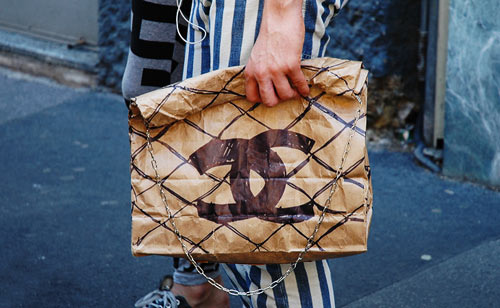The new Chanel (grocery) bag
The hot new Chanel bag this season is a brown paper bag.

As one of the commenters says, “fake it until you make it”.



This site is made possible by member support. 💞
Big thanks to Arcustech for hosting the site and offering amazing tech support.
When you buy through links on kottke.org, I may earn an affiliate commission. Thanks for supporting the site!
kottke.org. home of fine hypertext products since 1998.
The hot new Chanel bag this season is a brown paper bag.

As one of the commenters says, “fake it until you make it”.
Profile of fashion designer Karl Lagerfeld, who admits he doesn’t know “what ‘normal’ means”.
When you read up on Hong Kong prior to visiting, most guides make mention of the different levels of the city. Physical levels, that is.[1] The city proper is built on a hill and there are so many tall buildings that you quickly lose interest in counting all of them; imagine Nob Hill in San Francisco, except with skyscrapers. The famous escalator cuts through the city up the hill; the change in elevation over its short span is impressive, especially when you get to the top and realize you’re actually only a few horizontal blocks from where you started.
Much of the HK’s retail and dining is vertically oriented; there’s just not enough storefront real estate to contain it all. You’ll typically find restaurants on the 3rd or 4th floor of buildings and 3- to 6-level malls jammed with retail stores are everywhere; the Muji we went to was on level 7 of Langham Place. Skyways connect buildings together — as do subways — so much of the foot traffic in some areas isn’t even on the street level. Cars and buses (with two levels) zoom on highways passing over city streets and other highways, past the midlevels of buildings just a block or two away and down the hill. As a pedestrian, you can find yourself staring up at a 50-story building in front of you and then turning slightly to peer into the 15th floor of a building 2-3 blocks away. It’s a disorienting sensation, being on the ground level and the 15th floor at the same time, as if the fabric of space had folded back onto itself. Many people aren’t used to negotiating cities so intensively 3-D, particularly when all the maps reinforce the Flatlandness of the city grid.
[1] Well, not entirely physical. There are economic levels for one; the woman selling eggs on the street for a couple of HK$ each while tourists shop for Prada and Burberry only blocks away. You’ve got British culture over Chinese culture…and then Chinese culture layering back over that since the handover in 1997. You’ve got different levels of authenticity, from the fake electronics & handbags to the real Chanel cosmetics & Swarovski crystal, from the more touristy, mediated experiences to the hidden corners of real Hong Kong.
The Chanel exhibition at the Met showcases the fashion designs of Coco Chanel as well as the more recent fashions of Karl Lagerfeld’s design. The exhibition attempts to draw parallels between the older Chanel fashions and Lagerfeld’s newer work (words like “interpretation” and “reinvention” sprinkled the exhibition walls), but I had a hard time seeing Coco’s influence in much of his work. Seems more like Lagerfeld is out on his own, which is in keeping with his thoughts in this 2001 interview with Paper magazine. Initially he says he hates “nothing more than people who only look in one direction, which means only in their direction” but then that he finds it hard to collaborate with others (except with himself). Then:
When I do my own things, I’m not really too interested in other people telling me what to do.
Lagerfeld is a fascinating figure and may have captured the cultural zeitgeist of the 80s and 90s in Chanel’s fashions, but I don’t know if I buy any of this reinvention business. If you’d like the check out the exhibit for yourself, you’d better hurry…it’s only on for a few more days.
Stay Connected